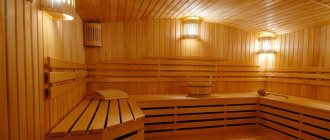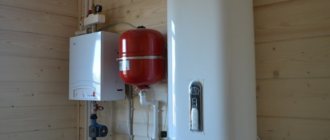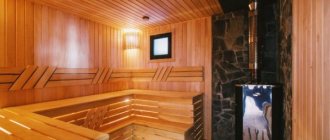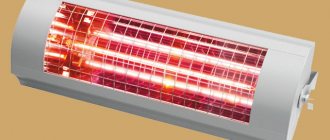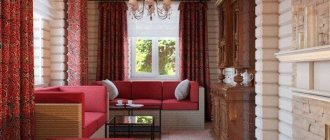Properly selected and installed bath lamps are not just a source of lighting. This is an important element of a comfortable stay and a pleasant pastime. At the same time, we should not forget that the bathhouse has high humidity and temperature. Therefore, when choosing a lamp for a steam room, wash room, etc., you should also think about safety precautions.
For a bath, you need to choose lamps that can withstand high temperature and humidity
Safety regulations
Lamps for saunas and baths will illuminate a room where the temperature reaches 100-120°C. Therefore, they must have sufficient heat resistance.
High humidity is another source of potential danger when operating lighting fixtures. Therefore, a lamp for a steam room in a bathhouse or washroom must be waterproof. Additional protection will be provided by sealed lampshades that are resistant to moisture and high temperatures.
It is necessary to choose sealed lampshades for the bath
It is better to install lighting sources under the ceiling or in the corners of the room. In this case, it will be possible to avoid accidental contacts and/or mechanical damage to lighting devices due to negligence. When choosing lampshades, the main condition is tightness. To give additional aesthetic properties to a simple lamp, you can use openwork wooden overlays in the form of gratings or carved screens.
It is better to install lighting in the corners of the room under the ceiling
Wooden grilles are often used to refract lighting in a bathhouse and as lampshades.
Rules
Electrical wiring in a bathhouse is naturally different from wiring in a residential building. The room closest to the requirements is the bathroom. It also has high humidity, but the temperatures, of course, are different.
However, even in a bathhouse, not all rooms are equally problematic from an electrician’s point of view. So we would call the steam room and washing room the most “problematic”. The rest room, dressing room, bathroom and veranda do not require increased protection of wiring and devices.
Once we have already made detailed excerpts from the PUE, which mention baths, saunas or washrooms. Therefore, now we will limit ourselves to a rather condensed retelling of the rules for electrical wiring in a bathhouse.
Let's start with the location of the electrical panel. It is advisable to place it indoors and not outdoors. In this case, it is necessary to either use a dry room or ensure complete waterproofing of the shield. No pipelines (water supply, gas pipeline, sewerage) should pass near the switchboard.
According to the rules, the installation of an RCD is considered mandatory for wet rooms.
Wires should be led:
- (preferably, not necessarily) hidden in the steam room and washing room;
- open on the wooden walls of other rooms.
IMPORTANT! However, it should be remembered that in a steam room it is not advisable to run wires along the walls, even inside. That's right - make a through hole with a metal sleeve in the wall, through which wires for the lamp go into the steam room. The wires leading into the steam room must be made heat-resistant - with insulation made of silicone rubber - RKGM, PRKS
The wires leading to the steam room must be made heat-resistant - with insulation made of silicone rubber - RKGM, PRKS.
The ban on metal sleeves and corrugation applies only to steam rooms and washing rooms.
Wires can only be extended by welding, crimping, soldering or a similar method.
Switches and sockets should be located outside the steam room and washing room.
You will find a complete list of rules for wiring in a bathhouse and steam room at the link already given above.
How to choose fixtures and lamps for a bath
Modern industry produces a wide range of lamps for rooms with high humidity - baths, saunas, bathrooms. These devices can use lamps such as:
- incandescent lamps;
- LED;
- fiber optic.
Types of bath lamps
When choosing a specific lamp, you need to pay attention not only to its design, but also to the degree of protection. The required safety class is IP 56. Such lamps are resistant to moisture.
Safety class for bath lighting
The free space between the lampshade and the body is additionally protected by a special seal. Its integrity must be checked at the time of selection.
Nuanas! A properly selected lighting device will allow you to use ordinary incandescent lamps in the steam room and/or wash room. Allowable power - no higher than 60 W.
For a bath you need to choose low-power incandescent lamps, up to 60 W.
Incandescent lamps get very hot when burning. The temperature in the sauna room is usually high. The low power of the lamps will protect against fire. After all, the walls in a bathhouse are most often lined with wooden boards, clapboard, etc.
Types of designs
One cannot expect a wide variety of designs in this case. This is due to operating conditions .
Read more about bath lighting, with an analysis of all its components, here. All models that you find (or try to make yourself) will consist of a durable, moisture-resistant, heat-resistant base (the best in this regard is considered to be a ceramic base), inside of which the socket is attached, as well as a cap that is screwed on top, covers the lamp from splashes and scatters light through frosted (most often) glass.
Depending on how exactly the socket is fixed , the light bulb can either lie on one side on the base (this gives elongated oval or round, relatively flat shade shapes, something like a cabochon, if you know this cut shape),
or be perpendicular to it (the lampshade is a protruding, elongated bulb-cylinder),
Heat-resistant sauna lamp Lindner
or attached at an angle, which repeats the previous shape with one difference - the lampshade is tilted.
Linda
There is also an L-shaped design, in which the lamp is installed vertically in a cylindrical cap, some distance away from the wall due to the base.
The manufacturer can supply a standard E27 socket, suitable for incandescent, LED, and halogen lamps. Or he can supply a non-standard one, for example, E14 - this moment must be controlled and, when purchasing, you need to clarify whether the lamps that you were going to supply are suitable for this particular lamp.
The lampshade can be transparent or matte, made of glass or plastic. Plastic, of course, does not produce such fragments as glass, but its use at high temperatures is undesirable. This is where almost the only point of choice for a Russian bath lies - at its temperatures it is quite cost-effective to install plastic.
IMPORTANT! In all other respects, the lamps for the steam room are designed for moisture protection, which is exactly what is essential for a Russian bath.
LED lamps for baths
Many owners are interested in whether it is possible to install LED lamps in the bathhouse. To resolve all doubts, you need to familiarize yourself in more detail with the main technical characteristics of such light sources.
The advantage of LED strip is that it is not afraid of moisture
LED bath lamps have such wonderful properties as:
- moisture resistance;
- Fire safety;
- adjusting the direction and/or intensity of the light flux;
- acceptable price.
Using LED strips, you can achieve an interesting lighting design in a bathhouse.
The safety class of individual lamps is up to IP65 and higher. You can achieve very interesting effects by installing LED lamps in the bathhouse. Is it possible to light a steam room or wash room like this? Of course it is possible, and even necessary. LED lamps for baths are one of the most successful options. They are not afraid even of direct contact with water jets. The main disadvantage of LED lamps for baths and steam rooms is their rapid deterioration when exposed to high temperatures.
Protection classes of LED strips
It should be remembered that the remote control with which the LED lighting is controlled must be protected from moisture and dirt. To do this, you need to place it in a special case made of plastic film. Based on all of the above, each owner will be able to determine for himself whether LED lamps can be used in a bathhouse.
LED strip connection diagram
Conclusion
Lighting with 24V, 12V or 220V LED lamps for a steam room is quite possible - but this does not mean that this is the most optimal option. After all, you won’t be in the steam room for that long and won’t feel any significant savings.
Therefore, in order not to create problems during installation and then in operation, we advise you to use ordinary incandescent lamps as general lighting for the steam room. And for decorative lighting of the lower part, use either heat-resistant LED strips or lamps built into the floor.
Fiber optic lamps
A great option is fiber optic bath lamps. With their help, illumination is produced by light waves rather than electricity. Therefore, such systems are absolutely not afraid of water.
Fiber optic lamps for a steam room in a bathhouse can be installed without fear. The material from which they are made can withstand temperatures up to 180-200°C.
Fiber optic lighting device
With the help of fiber optic lamps, you can create an atmosphere of calm, coziness and spiritual comfort in the bathhouse. This promotes self-relaxation of the human body. The beneficial effects of bath procedures increase several times.
An example of fiber optic lighting in a bathhouse
Bath lampshade: shape
An interesting point: somehow it happened historically that there are two main forms - a grille and a screen. We will assume that other options, if they existed, died out due to some kind of unsuitability or inconsistency. Or the survivors turned out to be the simplest and most practical. (Of course, no one forbids doing something original; we are talking about the most common.)
Lattice
The question arises: what else could be made from slats or solid planks? The simplest and most effective way is to assemble a lattice, a kind of “fence,” leaving slits for light.
IMPORTANT! The brightness of the lighting depends on the width and number of slots.
However, even with the simplicity of the idea, variations can be sufficient - the slats can be attached to bases that will give the structure a cylindrical or conical shape, or they will be combinations of simple shapes, if you like.
BY THE WAY! The slats may not be solid - if you make a slotted pattern in them, then there will be a combination of a lattice and a screen.
The attractiveness of this form is that it harmonizes perfectly with walls finished with clapboard, or with log walls or timber. Overall, a lattice wood lampshade looks great on a wood wall. And the material for it can also be the remains of the same lining, unused during construction.
Screen
It differs from the previous version in the absence of slots between the slats. And also because some recognizable outline is usually carved into the central element. However, here, too, various variations are possible - there can be as many slotted elements as you like, not necessarily one central one.
Combinations with a lattice are possible, when a lattice is made on the sides, and in the center there is a solid strip with a cut out outline.
The slot can be left as is, without any inserts, or you can experiment - put a decorative or practical diffusing material on the back side, for example, mesh or frosted glass (we’re not talking about plastic, because it’s hot in the steam room). Without the matte material, the light may be too harsh.
ADVICE! Instead of matte material, you can use a plate with numerous small holes.
How to correctly position light sources in a steam room
Before installing lamps with one type of lighting lamp or another, you must carefully study the instructions and all the manufacturer’s instructions. It is very important to choose the right location for the light source.
In the steam room, where the temperature and humidity levels are especially high, only heat-resistant lighting fixtures can be installed. In this case, the lamps should be placed away from the stove. This is a must.
It is better to place lighting in the steam room away from the stove
The optimal location of the light source in the steam room is in the corner of the room and/or under the ceiling. In this case, you need to take into account the dimensions of the room and the size of the ceiling. The ceiling lamp should be located above human height. The corner lamp is installed so as to exclude the possibility of accidental contacts.
You can attach an LED strip along the wall under the ceiling. Under it you definitely need a base made of non-flammable heat-resistant material.
The LED strip can be placed under the shelves, but so that they do not interfere with visitors
The base for the LED strip and/or any other lighting device located in a Russian bathhouse must be made from a material such as:
- stainless steel;
- aluminum;
- heat-resistant plastic;
- ceramics (only for dry rooms).
To illuminate the steam room, it is better to use warm shades of lighting
Important! For a lamp in a sauna, where the humidity level is much lower, you can make a base from ceramic materials.
Where to place and what marking?
Having chosen the optimal type of lighting fixture for his bath, the owner should not calm down, since he still faces many unresolved problems. One of the priorities is where to install the lamps.
In the steam room
Here the owner must remember the rules prohibiting the installation of lamps in certain places. This is the area next to the stove. Even if you purchased a heat-resistant lamp, it is unlikely that it can withstand the flow of hot air coming from the hot walls for long.
All other zones are considered relatively safe, so here you can completely focus on personal preferences. It would not be a mistake to install lamps on a shelf. But you need to choose a place very carefully so that the lamps do not injure people.
A suitable place to install the lamp may be the corner of the steam room . This is a safe place in every sense: they definitely won’t interfere here. For a horizontal lamp, you can choose the place where the walls and ceiling connect. You can also consider more original lighting ideas: for example, if you manage to get a corner decorative screen, you can install it in the corner, first gluing an LED strip to a heat-resistant, non-flammable base.
For Finnish saunas, where dry air predominates, it is recommended to choose lamps with a ceramic base. All other options should not even be considered, since they are short-lived. If you are the proud owner of a Russian bathhouse, then you should know that the temperature in the steam room is kept at 50-75 °C . Therefore, you can choose any heat-resistant material for it. But do not forget about high humidity - the material you choose must have a moisture-resistant base. Copes best with moisture:
- stainless steel;
- aluminum;
- heat-resistant plastics.
But when choosing, be sure to take into account the operating temperature, which should be at least 100 °C.
In the washing room
They want the temperature in the sink to be kept at the usual level, but high humidity and splashing water can create a problem. Contact with electricity may cause a fire. In this room it is best to install lighting fixtures with a protection class appropriate for a bathroom. When choosing, be sure to consider how high the risk of water getting on the lampshade is.
In each room, we can conditionally distinguish three zones in which lighting devices of a certain protection class can be installed:
- First zone. An area near a water source, such as a shower stall. Given the high humidity, there is the highest probability of water entering in large quantities and from any direction. For this zone, it is recommended to choose 20 W lamps with a protection class of at least 5 (IP 45, 46, 47, 55, 56, etc.).
- Second zone. A part of the room located at a distance of 60 cm from a water source - a bathtub, a swimming pool, etc. The likelihood of drops of moisture getting into this area is much lower, so you can limit yourself to installing devices with protection class 4 and higher.
- Third zone. It is characterized by a fairly low level of humidity, which allows the installation of lighting devices with moisture protection class 1 and higher.
In the rest room
A room in which the humidity level remains consistently high. Taking this into account, it is necessary to choose lamps that have at least a minimum moisture protection class of 1 and higher.
Correct lighting for the washing area
In a small wash room, 1 lamp will be enough. The lampshade must be sealed to prevent water splashing on the lamp and/or socket.
Wiring for lighting fixtures in the bathhouse must be insulated especially carefully. This will prevent accidental contact of moisture and electricity.
Lighting in the washing room should also be moisture-proof
A large wash room requires the installation of several lamps. Therefore, when choosing their location, you need to take into account the location of the bathtub, sink, bidet, shower stall. It is better to do preliminary zoning of the premises.
As a rule, the washing room is divided into 3 zones:
- in close proximity to a source of moisture;
- at a distance of 0.6 m;
- in a relatively dry space.
Moisture levels are highest near a water source. Therefore, in this area you can install 12 volt bath lamps and lamps. IP indicator for protection against moisture is at least 45 units.
A zone located approximately 60 cm from a direct source of moisture is considered remote from moisture. Here you can use lamps and lamps with an average level of protection.
LED lighting can even be used in a swimming pool
In a dry area, located away from faucets, shower heads, swimming pools, etc., you can use lighting fixtures and lamps with the lowest level of protection.
Installation of wiring in a bathhouse or sauna
- Wooden walls and finishing elements, shelves are impregnated with substances that prevent fire.
- Cables are laid in straight lines, at a distance of 10-15 cm from the floor, ceiling, and water pipes. When turning, the angle should be 900.
- The distance to heating devices and stoves should be at least 50-60 cm.
- Switches are mounted at a height of 1.5 m from the floor, sockets - 0.5 m. For baths and saunas, choose products in waterproof cases. The wires are connected to them from below so that drops of water do not get inside the devices.
- All wire connections are carefully fixed with twists or soldered, the terminals are tightened well, after which the connection point is insulated.
In the steam room, the most dangerous area, only lamps are placed. All other devices and devices (transformers, dimmers, switches, sockets) are installed in the dressing room, rest room or washroom.
Lighting for the rest room and other rooms
There is no constant high humidity in the rest room. Therefore, lighting fixtures with a minimum level of protection can be used here.
Electrical diagram of the bath
The dressing room, billiard room, dressing room and other additional rooms can be illuminated as living rooms. However, it is still better to use sealed lampshades made of durable material.
Operating conditions and requirements
Choosing suitable lamps for baths and saunas is quite difficult, since it is necessary to take into account special operating conditions:
- high level of humidity;
- temperature changes during heating and cooling of heating equipment.
This means that for the main functional rooms of the steam room, it is recommended to use special waterproof bath lamps of a sealed design that are resistant to overheating and the negative effects of moisture.
To ensure maximum safety in the steam room, waterproof bath lamps are equipped with special shades made of heat-resistant materials.
Lighting equipment intended for saunas and baths has the following characteristics:
- high quality materials for the manufacture of devices;
- high degree of moisture protection - from IP40 and above;
- resistance to high humidity;
- resistance to temperature changes and heating;
- heat resistance level for wall-mounted devices – up to 160 degrees, for ceiling devices – up to 300;
- high lighting characteristics;
- available adjustment of luminous flux.
Article on the topic: 20 acres, how many meters of fence
Many models of lamps provide additional decorative effects - flickering, blinking, attenuation and dispersion. This makes it possible to use bath lamps as stylish decorative elements.
The lighting equipment market offers a wide selection of bath lamps:
- devices using incandescent light bulbs;
- LED bulbs;
- fiber optic lighting devices.
Energy-saving lamps
Energy-saving lamps can be installed in a bathhouse only in rooms with low heat levels. Such light sources can withstand temperatures no higher than 60°C. Therefore, it is dangerous to use such lamps in a steam room that heats up to 100°C or higher. Energy-saving lamps can be used in other rooms of the bathhouse - wash room, dressing room, rest room, etc.
Energy-saving lamps can only be used in the locker room and vestibule
Manufacturers
As always, when choosing any equipment, the question arises about the manufacturer: whose products are better to buy. Finnish companies Tylo and Harvia have long been leaders in the segment of lamps for baths and saunas. They produce heat-resistant lamps. They are worth buying for the steam room. Although their price tag is decent, they are distinguished by high quality and reliability, and have been tested more than once or twice in numerous baths and saunas.
In other rooms you can get by with more budget products. Linder lamps have more affordable prices, but their quality is lower. They are usually recommended to be installed not in a steam room, but in a dressing room, shower or locker room.
In general, there are many German, Czech and even Russian companies that make such equipment. Look for those that suit you in terms of characteristics, not the manufacturers.
Infrared lamps
Recently, infrared lamps for baths or saunas have become increasingly popular. The average power of such light sources ranges from 250 to 300 W.
The frequency of infrared radiation is about 1400-3000 nm. For technical connections when installing such devices, silicone wire is used.
Infrared radiation
A special remote control allows you to vary the radiation intensity. This allows you to set the required temperature and creates all the conditions for comfortable rest and recovery.
Infrared equipment - heaters, lamps, etc. - can be installed without much difficulty. The main thing is to strictly follow the manufacturer's recommendations. The number of emitters is selected in accordance with the dimensions of the room.
Location of infrared heaters in the steam room
Lamps: which ones can be installed, which is better
In addition to choosing the shape of the lampshade, you also need to decide what kind of lamps you will put in it.
In the bathhouse, 60-watt incandescent lamps, LED lamps and strips, as well as halogen and fiber-optic light sources are acceptable.
Bath light bulbs: incandescent lamps
In the old days, there simply weren’t any other options. However, this variety is very fragile and sensitive not only to mechanical stress, but also to sudden temperature changes, for example, when water gets on the flask. Therefore, they are dangerous by the very presence of glass and a red-hot spiral.
Another factor not in their favor is the voltage they consume - 220 volts can kill a person if the unexpected happens. Although there are 36 volt light bulbs, they can work through a transformer.
You can protect yourself from electric shock by installing an RCD (more details in this and this article on our website). In this case, the current will turn off so quickly that it will not have time to harm a person. And the lampshade with a mesh should protect the flask from mechanical destruction.
CONCLUSION: you can use such light bulbs for a bath not only in dry rooms, but also in wet ones, including a steam room. But taking into account protective measures. In addition, this is the most budget-friendly type.
Fiber optic
Optical fiber is not cheap, but if this is not a question, then it can be used to illuminate a relaxation room, a steam room, and a swimming pool.
On sale you will find two types of cables - with side and end glow. The difference is clear: in the former, the light spreads from the entire surface of the cable, while in the latter, the cable itself does not glow, but a bright light shines from the cut at its end. A cable with a side glow may have internal notches that make the glow inhomogeneous and chaotic.
Both varieties are suitable for installation in bathhouses.
The lamp structure includes a projector and cables of the required length.
ATTENTION! If you intend to use fiber optics in the steam room, then the projector must be located outside it, although not too far, literally behind the wall.
The projector can be equipped with crystals and discs of different colors.
LEDs
In principle, if you are interested in this topic, you can look at a large material dedicated only to LEDs for baths.
Here we will describe them briefly. LEDs can be a strip or a lamp. The latter is screwed into a regular socket; the mains voltage can be 220 or 12 V.
To power 12-volt LEDs, either a step-down transformer or a power supply is used. If a power supply is used, it must have galvanic isolation, which ensures that even in the event of a failure, 220 V will not flow to the consumer.
LEDs are sensitive to two factors - current fluctuations in the network and high temperature (above 65 degrees on the chip). This shortens their service life.
Installing them in a steam room is undesirable, but beneficial - low voltage, low energy consumption. Therefore, the high temperature trade-off is usually resolved by mounting the LEDs low in height (where the temperature is lower). If these are tapes, then they are laid under and behind the shelf.
IMPORTANT! Tapes used in wet rooms must have a high degree of moisture protection - placed in a transparent sealed tube, at a minimum. As a maximum, transparent silicone is filled inside the tube.
Salt lamps
A wonderful option offered by modern industry is salt lamps for baths. These are not just lighting fixtures. With their help, you can thoroughly improve your health and get much more pleasure from hygiene procedures and sauna relaxation.
A variety of salt lamps can be used in the bath
Modern salt lamps for baths help achieve such wonderful effects as:
- elimination of harmful microorganisms;
- destruction of allergens;
- effective ionization of indoor air;
- saturating the body with healing vapors.
Salt panels on the walls in the bathhouse heal the body.
Salt lighting fixtures are manufactured industrially from Himalayan salt, mined by hand. The main elements of a salt lamp are:
- stand;
- power cord;
- electric lamp;
- cartridge;
- lampshade.
Special mention should be made about lampshades for salt lighting fixtures. They are made from Himalayan salt crystals. Such lampshades have different sizes, shapes and colors. Therefore, they are easy to choose for any original interior.
Salt lighting in the lampshade can be placed in the corner
High-quality salt lamps are durable, practical, and silent. The main care for such a device is keeping it clean and periodically changing the light bulb.
Note! The beneficial properties of the Himalayan salt from which the lampshades are made are preserved for many years. The intensity of salt radiation remains at the original level.
Salt lamps create a favorable internal atmosphere in various rooms of the bathhouse. This helps get rid of stress and fatigue, calm the nervous system and saturate the body with vital elements.
What materials are suitable for lamps in the steam room
The choice of material from which the lamps in the bathhouse will be made should be approached responsibly. Firstly, the devices must fit into the overall environment and be in harmony with the design of the premises. Secondly, you need to choose a material that will withstand the test of temperature and humidity, and also protect the lamp from their harmful effects.
Most often, the following types of lamps are used in the bath:
- wooden;
- glass (ceramic);
- salt.
In addition, the lamp shell performs the function of dispersion. It is advisable to choose a material that will soften the flow of light and create a cozy atmosphere in the bathhouse.
Glass lamp for a bath with a decorative wooden box
Unique properties of lamps for steam rooms made of Himalayan salt
Lamps made from Himalayan salt are especially popular. This material is mined at the bottom of a lake that dried up 250 million years ago. It contains about a hundred different minerals. The uniqueness of salt lamps for baths lies in the fact that when heated, the material releases particles that have a beneficial effect on human health and well-being.
Himalayan salt has a very dense structure. It is also used as a building material. Bricks are made from salt, which are used to build walls in the steam room, as well as decorative elements. When the room is heated, the effect of the sea coast is created. Mineral vapors help cure asthma and bronchitis.
When heated, Himalayan salt also releases negative ions. They perfectly disinfect the air. This process starts when the room temperature exceeds 60°C.
Most often, lamps made from Himalayan salt are made in the form of a diffusing screen. Although you can find models made of plates or in the form of a container filled with lump material.
Important! The air humidity in the room should not exceed 50%, otherwise the salt in the lamp will quickly become damp and lose its beneficial properties.
The steam room wall is made of Himalayan salt with lighting
Review and characteristics of ceramic bath lamps
Ceramic lamps are the most common type of fixture. They are widely used for lighting all types of premises, including bathhouses. The base of such devices is made of ceramic, and the lampshade is made of glass. There are models made of plastic, for example, Harvia. But, despite the quality of the manufacturer, such lampshades melt in the steam room. For this reason, it is recommended to give preference to glass shades, although there is a risk of getting cuts if the lamp is accidentally damaged.
The glass cover in combination with the ceramic base protects the lamp inside from exposure to high temperatures and moisture penetration.
Manufacturers offer several installation options:
- Parallel - the lamp fits tightly to the wall, and its bulb is located parallel to the base.
- At an angle - the design is called “corner”, although it is not a type of corner lamp; in a bathhouse it is installed at an angle to the wall.
- Perpendicular – the light bulb is positioned perpendicular to the base.
Despite the declared heat resistance, ceramic lamps are not recommended to be installed directly on the ceiling base. Installation can be done on the wall at the top of the room.
Ceramic sauna lamp TDM Electric
The main types of wooden lamps for a bath
Wood is the best solution. This material meets all the above requirements. Most often, the walls and ceilings of the bathhouse are made of wood, so such devices go well with the decor. The material is of natural origin and safe for humans. Its surface is pleasant to the touch.
A wooden lamp in a bathhouse means a lamp with a shade made of heat-resistant glass, which is covered with a wooden lampshade. Some manufacturers offer this decorative protection complete with the main device, in other cases it can be purchased separately or made by yourself.
Wooden lampshades come in two types:
- Screens.
- Lattices.
Combination options can also be found on sale. According to the installation method, they are divided into corner lamps for baths and wall lamps.
Protective screens consist of a single sheet. The front part of such lampshades is made of plywood or thin furniture panels. The material is decorated with shaped holes that transmit light from the lamp. On the back side of the screen, these slits are covered with mesh.
Wooden lamps are the most common lighting option in the sauna.
Lattice-type structures consist of slats and small slats. Before assembly, they are processed, giving the product an artistic look. Slots are left between the bars of the grille through which the light from the lamp will pass.
Note! When choosing a design, you need to pay attention to the width of these gaps. The larger the slots, the more light will penetrate into the room.
Screens made of wood and grilles muffle and diffuse light and prevent excess moisture from reaching the surface of the glass. In addition, they act as decoration and also protect the lamp from mechanical damage.
Many craftsmen make their own lamps from wood. This material is affordable and easily amenable to any type of processing. You can create a product of any shape from wood, decorate it with carvings, beautiful ornaments and other decor.
How to make a grate for a lamp in a bathhouse with your own hands from wood
A lattice of wooden slats not only diffuses light, but also creates a relaxing, cozy atmosphere. Passing through it, the light casts beautiful highlights and shadows on all surfaces in the room.
Scheme for making a wooden grille for a lamp with your own hands
The grille consists of a main frame and small slats (slats) that are fixed to it from the bottom and top. Additional decorative elements can be added to this design. If you use materials that were left after finishing work in the steam room to create these decorations, the design of the lamp will be combined in texture and color with the design of the room.
Before you start creating a lattice, you need to think through the main details and take into account several nuances:
- The shape of the frame - the design can be different. It all depends on the design of the lamp and its location. Wall-mounted units have a rectangular or round frame. The basis of corner lamps for a sauna is trapezoidal or triangular.
- Safety – the size of the slats is selected taking into account the overall dimensions of the lamp and the chosen design for the grille. All sharp areas on parts and corners must be rounded and thoroughly sanded. This will ensure safe operation of the device. Sanding will give the grill a neat and finished appearance.
- Fixation – it is advisable to fasten the parts together with self-tapping screws, but this should be done from the back side of the grille. This is necessary so that the steel caps do not spoil the appearance of the product. In addition, the metal will become very hot. The absence of steel elements on the outside eliminates the possibility of getting burned if a person accidentally touches the lamp in the steam room.
You can make a wooden sauna lamp yourself
To create a lattice with a strict geometric design, rectangular planks are suitable. They can be attached to the frame parallel to each other or crossed. To obtain an elegant product, figured slats are used. No special knowledge is required to create concave or convex curves. Even a beginner can cope with this task.
Helpful advice! If you use larch or cedar wood as a material for the grate, you can get a durable product that, when heated, will fill the room with a pleasant aroma.
Fiber optic bath lighting - a modern solution
There is another type of bath lamps, which I have already mentioned in passing - fiber optic ones. In them, the light source can be any lamp (usually LED) placed at some distance from the illuminated room. Light into this room from the lamp passes through special fiber optic light guides - glass, most often flexible tubes.
Article on the topic: In which bathhouse was Brother 2 filmed?
The operating principle of a fiber optic line and a lamp built on its basis
What are the benefits of using such a lamp in a bathhouse? First of all, complete electrical safety: neither light guides nor end lamps need voltage.
Lamp attachments for fiber optics can be of various shapes and coverage angles
The lamp can be placed in a relatively dry room in the bathhouse, say, in the dressing room. The optical fiber is not affected by either humidity or temperature, which means the structure is durable. Finally, such lamps are very aesthetic, easily fit into any interior and, thanks to the flexibility of the fibers, can be located anywhere in the room.
An example of using fiber optic lamps in a bathhouse
Installation recommendations
Not only well-chosen lighting fixtures are important when arranging a bathhouse, but also their correct installation. This issue is especially relevant for steam rooms where operating conditions are difficult. Among the main requirements for organizing lamps are:
- It is prohibited to place lamps near the stove, regardless of their degree of heat resistance;
- It is more expedient to install them on the wall opposite to it;
- you need to calculate the distance from the floor to the chandelier so as not to hit it with your head.
Article on the topic: What is a heater for a bath
It is best to place lighting fixtures in the corner of the room or where the walls and ceiling intersect.
